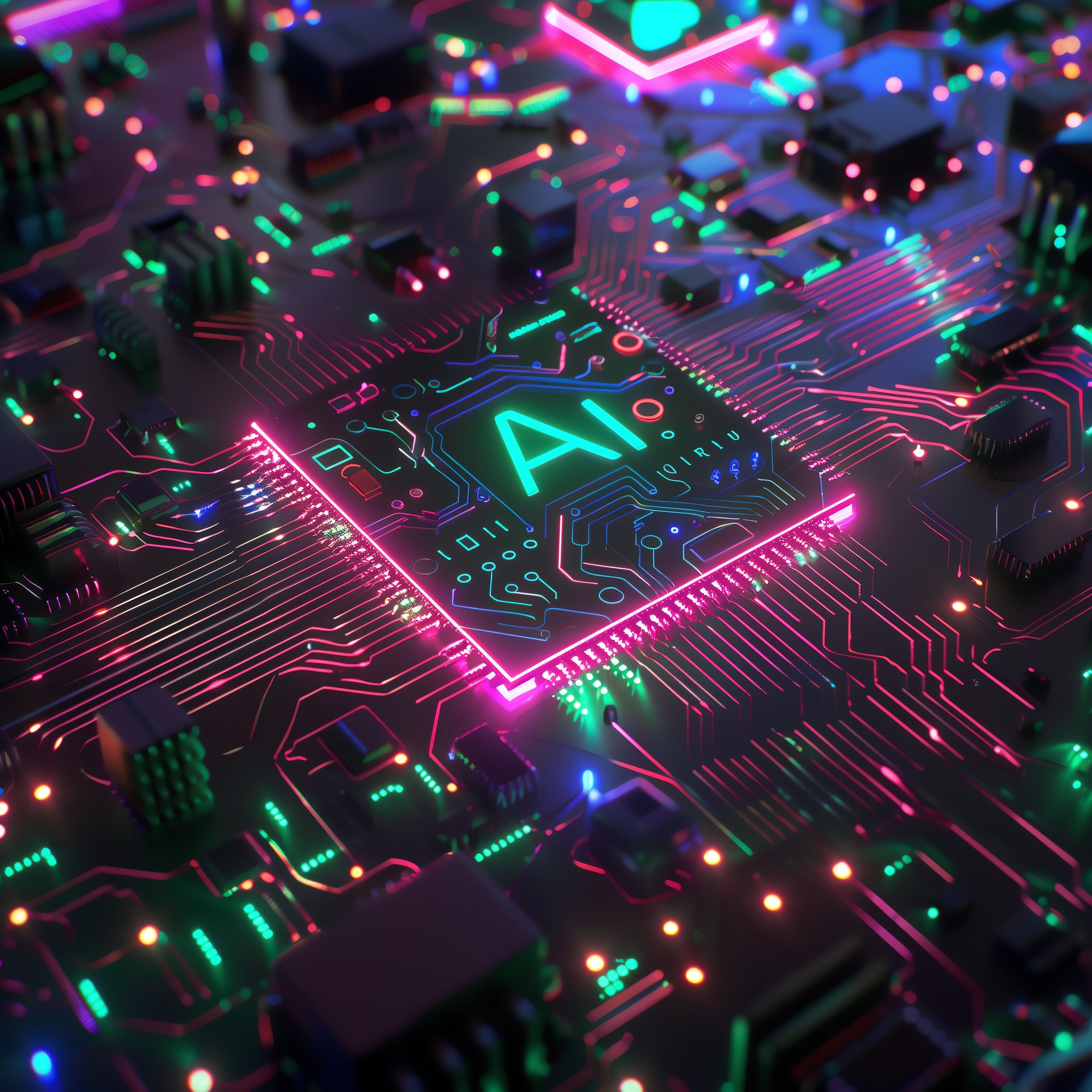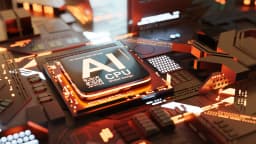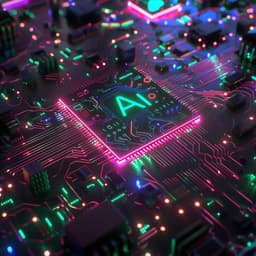
Artificial Intelligence (AI) chips are specialized processors designed to efficiently handle AI-related tasks, such as machine learning, deep learning, and neural network computations. These chips have revolutionized industries by offering unprecedented speed, efficiency, and scalability. In this detailed blog, we will explore AI chips, their applications, composition, types, and the leading companies in the industry. We will also provide a comparison table, an AI chips list, and an FAQ section to address common questions about AI chips.
What Are AI Chips?
AI chips are specialized semiconductors optimized for processing AI workloads. Unlike traditional CPUs, AI chips are designed to handle parallel computations, enabling faster execution of machine learning algorithms and deep neural networks. These chips power applications ranging from natural language processing (NLP) and computer vision to autonomous vehicles and robotics.
AI chips include graphics processing units (GPUs), field-programmable gate arrays (FPGAs), and application-specific integrated circuits (ASICs) that are specialized for AI. General-purpose chips like central processing units (CPUs) can also be used for some simpler AI tasks, but CPUs are becoming less and less useful as AI advances.
History and Evolution of AI Chips
The development of AI chips has evolved significantly over the years:
1. Early AI Computing (1950s-1980s): AI computations were initially performed using general-purpose CPUs, which had limited processing power for AI workloads.
2. Rise of GPUs (1990s-2000s): Graphics Processing Units (GPUs) became popular due to their parallel processing capabilities, enabling faster deep learning computations.
3. Emergence of TPUs and ASICs (2010s-Present): Companies like Google, Intel, and Nvidia developed specialized AI accelerators, including Tensor Processing Units (TPUs) and Application-Specific Integrated Circuits (ASICs), for optimized performance.
4. Future Trends (Beyond 2025): The future of AI chips includes neuromorphic computing, quantum AI processors, and more energy-efficient AI architectures.
Types of AI chips
There are several different kinds of AI chips that vary in both design and purpose.
GPUs
Graphics processing units, or GPUs, are electronic circuits designed to speed computer graphics and image processing on various devices, including video cards, system boards, mobile phones and personal computers (PCs).
Although they were initially built for graphics purposes, GPU chips have become indispensable in the training of AI models due to their parallel processing abilities. Developers typically connect multiple GPUs to the same AI system so they can benefit from even greater processing power.
FGPAs
Field programmable gate arrays (FPGAs) are bespoke, programmable AI chips that require specialized reprogramming knowledge. Unlike other AI chips, which are often purpose-built for a specific application, FPGAs have a unique design that features a series of interconnected and configurable logic blocks. FPGAs are reprogrammable on a hardware level, enabling a higher level of customization.
NPUs
Neural processing units (NPUs) are AI chips built specifically for deep learning and neural networks and the large volumes of data these workloads require. NPUs can process large amounts of data faster than other chips and perform various AI tasks such as image recognition and NLP capabilities for popular applications like ChatGPT.
ASICs
Application-specific integrated circuits (ASICs) are chips custom-built for AI applications and cannot be reprogrammed like FPGAs. However, since they are constructed with a singular purpose in mind, often the acceleration of AI workloads, they typically outperform their more general counterparts.
What Are AI Chips Made Of?
AI chips are composed of various materials and architectures to optimize efficiency and processing power. The main components include:
• Semiconductor Material: AI chips are typically made from silicon, though emerging materials like gallium nitride (GaN) and graphene are being researched for improved performance.
• Processing Units: AI chips contain multiple cores, tensor processing units (TPUs), and neural processing units (NPUs) for enhanced parallel computation.
• Memory: High-bandwidth memory (HBM) and low-latency cache architectures help AI chips process vast amounts of data in real time.
• Interconnects: High-speed interconnects ensure seamless data transfer between different processing elements within the chip.
• Power Optimization Mechanisms: AI chips use dynamic voltage and frequency scaling (DVFS) and specialized cooling mechanisms to maintain efficiency.
How Do AI Chips Work?
In general, a chip refers to a microchip, which is an integrated circuit unit that has been manufactured at a microscopic scale using semiconductor material. Components like transistors (tiny switches that control the flow of electrical current within a circuit) are etched into this material to power computing functions, such as memory and logic. While memory chips manage data storage and retrieval, logic chips serve as the brains behind the operation that processes the data.
AI chips largely work on the logic side, handling the intensive data processing needs of AI workloads — a task beyond the capacity of general-purpose chips like CPUs. To achieve this, they tend to incorporate a large amount of faster, smaller and more efficient transistors. This design allows them to perform more computations per unit of energy, resulting in faster processing speeds and lower energy consumption compared to chips with larger and fewer transistors.
AI chips also feature unique capabilities that dramatically accelerate the computations required by AI algorithms. This includes parallel processing — meaning they can perform multiple calculations at the same time. Chips can have different functions; for example, memory chips typically store and retrieve data while logic chips perform complex operations that enable the processing of data. AI chips are logic chips, processing the large volumes of data needed for AI workloads. Their transistors are typically smaller and more efficient than those in standard chips, giving them faster processing capabilities and smaller energy footprints.
Why are AI chips important?
The AI industry is advancing at a rapid pace, with breakthroughs in ML and generative AI in the news almost every day. As AI technology develops, AI chips have become essential in creating AI solutions at scale. For example, delivering a modern AI application like facial recognition or large-scale data analysis using a traditional CPU—or even an AI chip from a few years ago—would cost exponentially more. Modern AI chips are superior to their predecessors in 4 critical ways: they're faster, higher performing, more flexible and more efficient.
• Speed
AI chips use a different, faster computing method than previous generations of chips. Parallel processing, also known as parallel computing, is the process of dividing large, complex problems or tasks into smaller, simpler ones. While older chips use a process called sequential processing (moving from one calculation to the next), AI chips perform thousands, millions—even billions—of calculations at once. This capability allows AI chips to tackle large, complex problems by dividing them up into smaller ones and solving them at the same time, exponentially increasing their speed.
• Flexibility
AI chips are much more customizable than their counterparts and can be built for a specific AI function or training model. ASIC AI chips, for example, are extremely small and highly programmable and have been used in a wide range of applications—from cell phones to defense satellites. Unlike traditional CPUs, AI chips are built to meet the requirements and compute demands of typical AI tasks, a feature that has helped drive rapid advancements and innovations in the AI industry.
• Efficiency
Modern AI chips require less energy than previous generations. This is largely due to improvements in chip technology that allow AI chips to distribute their tasks more efficiently than older chips. Modern chip features like low-precision arithmetic enable AI chips to solve problems with fewer transistors and, therefore, lesser energy consumption. These eco-friendly improvements can help lower the carbon footprint of resource-intensive operations like data centers.
• Performance
Since AI chips are purpose-built, often with a highly specific task in mind, they deliver more accurate results when performing core tasks like natural language processing (NLP) or data analysis. This level of precision is increasingly necessary as AI technology is applied in areas where speed and accuracy are critical, like medicine.
AI Chips List
Here is a list of some of the best AI chips available today:
• Nvidia H100 – High-performance AI chip designed for deep learning and AI inference.
• Google TPU v4 – Optimized for large-scale machine learning and AI workloads.
• Intel Habana Gaudi2 – AI accelerator for deep learning models.
• AMD Instinct MI300 – AI and HPC-focused GPU for cloud AI workloads.
• Graphcore IPU – Designed for AI inference and model training.
• Tesla Dojo – AI chip tailored for self-driving AI training.
• Cerebras CS-2 – Large AI processor for AI model training.
• IBM TrueNorth – Neuromorphic chip mimicking brain-like computations.
• Qualcomm AI Engine – AI chip for mobile and edge computing.
• Huawei Ascend 910 – AI chip optimized for cloud-based AI workloads.
AI Chips vs GPU: Which Is Better?
Like general-purpose CPUs, AI chips gain speed and efficiency (that is, they are able to complete more computations per unit of energy consumed) by incorporating huge numbers of smaller and smaller transistors, which run faster and consume less energy than larger transistors. But unlike CPUs, AI chips also have other, AI-optimized design features. These features dramatically accelerate the identical, predictable, independent calculations required by AI algorithms.
They include executing a large number of calculations in parallel rather than sequentially, as in CPUs; calculating numbers with low precision in a way that successfully implements AI algorithms but reduces the number of transistors needed for the same calculation; speeding up memory access by, for example, storing an entire AI algorithm in a single AI chip; and using programming languages built specifically to efficiently translate AI computer code for execution on an AI chip.
| Feature | AI Chips | GPUs |
| Processing Efficiency | Optimized for AI workloads | General-purpose computing, good for AI but not specialized |
| Power Consumption | Lower power consumption | Higher power consumption |
| Performance | Faster inference and AI model processing | Slower AI processing compared to dedicated AI chips |
| Flexibility | Designed for specific AI applications | More versatile, can handle various computing tasks |
| Cost | Generally expensive but optimized for AI | More affordable and widely available |
AI Chips Companies
All types of AI eat massive amounts of high-speed computing power for lunch — and for breakfast and dinner. That means that at the core of everything, AI is a powerful processor, a chip created from silicon and innovation. The companies that build the fastest and smallest chips, perhaps those that can deliver high-power computing without drinking the planet’s resources, will win the heart — and investment dollars — of this industry. But it takes time and a huge investment to build this technology. And the race is already hot.
AI’s ravenous appetite for compute power is pushing the edge of Moore’s Law and forcing chip designers and chipmakers to innovate in ways they haven’t had to in years. Silicon has been creating wealth for decades. But this is a new gold rush. Many companies are developing AI chips to power the next generation of computing. Some of the top AI chip manufacturers include:
• Nvidia – Leading AI GPU manufacturer with specialized AI chips like the H100.
• Google – Developed the Tensor Processing Unit (TPU) for AI workloads.
• Intel – Offers AI chips like the Habana Gaudi2 and Nervana series.
• AMD – Competes in the AI market with its Instinct MI series GPUs.
• Graphcore – Develops the Intelligence Processing Unit (IPU) for AI training.
• Tesla – Designed the Dojo AI chip for autonomous driving.
• Cerebras – Created the largest AI processor for deep learning models.
• Huawei – Produces AI chips like the Ascend series for AI research and cloud computing.
What Are AI Chips Used For?
When it comes to the development and deployment of artificial intelligence, AI chips are much better than regular chips, thanks to their many distinctive design attributes. AI chips are utilized across various industries to accelerate AI-driven tasks. Modern artificial intelligence simply would not be possible without these specialized AI chips. Here are just some of the ways they are being used. Some of their primary applications include:
1. Autonomous Vehicles
AI chips power self-driving technology by processing sensor data, recognizing objects, and making real-time driving decisions. Companies like Tesla, Waymo, and NVIDIA utilize AI chips to enhance vehicle automation.
2. Natural Language Processing (NLP)
AI-powered assistants like Alexa, Siri, and Google Assistant rely on AI chips to process voice commands and generate human-like responses. AI chips also enhance chatbots, machine translation, and sentiment analysis.
3. Healthcare and Drug Discovery
AI chips enable advanced diagnostics, medical imaging, and drug discovery by analyzing massive datasets quickly and accurately. AI is used for tumor detection, personalized medicine, and genomics research.
4. Financial Services
Banks and financial institutions leverage AI chips for fraud detection, risk assessment, and high-frequency trading. AI-driven models predict market trends and optimize investment strategies.
5. Robotics and Automation
AI chips enhance industrial robots, enabling them to perform complex tasks with precision and efficiency. AI-powered automation is widely used in manufacturing, logistics, and customer service.
6. Gaming and Graphics Processing
AI chips significantly enhance gaming experiences by improving real-time rendering, physics simulations, and character behavior modeling. AI-powered upscaling technologies like NVIDIA DLSS optimize game performance.
7. Edge AI and IoT
AI chips are increasingly deployed in edge devices such as smart cameras, drones, and IoT sensors. Edge AI reduces latency and enhances real-time decision-making without relying on cloud computing.
Future of AI Chips
While AI chips play a crucial role in advancing the capabilities of AI, their future is full of challenges, such as supply chain bottlenecks, a fragile geopolitical landscape and computational constraints.
1. Neuromorphic Computing
Neuromorphic chips mimic the structure of the human brain and enhance AI capabilities in energy-efficient learning and inference tasks.
2. Quantum AI Processors
Quantum computing integration with AI chips aims to solve complex problems exponentially faster than classical processors.
3. AI-Optimized Memory and Storage
Future AI chips will feature enhanced memory architectures, including 3D-stacked memory and optical computing for faster data access.
4. Energy-Efficient AI Chips
With the growing demand for AI, chip manufacturers focus on improving energy efficiency and sustainability using AI-optimized architectures.
FAQ About AI Chips
1. Are AI chips better than GPUs?
AI chips are optimized for AI workloads, making them more efficient than GPUs for specific tasks. However, GPUs remain versatile for a broader range of applications.
2. Can AI chips replace CPUs?
No, AI chips complement CPUs but do not replace them. CPUs handle general-purpose computing, while AI chips accelerate AI-specific tasks.
3. What is the most powerful AI chip?
Currently, Nvidia’s H100 and Google’s TPU v4 are among the most powerful AI chips available.
4. Do AI chips consume a lot of power?
Power consumption depends on the chip type. GPUs consume more power, whereas ASICs and TPUs are more power-efficient.
5. Are AI chips only used in AI applications?
Primarily, yes. However, AI chips are also used in gaming, scientific simulations, and other high-performance computing applications.
6. Which AI chip is best for personal use?
For personal AI applications like gaming, content creation, and deep learning experiments, Nvidia’s RTX series GPUs (such as RTX 4090) offer excellent AI performance.
7. How much do AI chips cost?
AI chip costs vary based on performance and application. High-end AI chips like Nvidia H100 can cost thousands of dollars, whereas consumer GPUs with AI capabilities start at a few hundred dollars.
8. What is the difference between AI accelerators and AI chips?
AI accelerators refer to hardware components that boost AI performance, including GPUs, TPUs, FPGAs, and ASICs. AI chips are a broader category that includes all dedicated AI processors.
Conclusion
AI chips have revolutionized computing by enabling faster, more efficient AI processing. With various types of AI chips available, including GPUs, TPUs, FPGAs, and ASICs, businesses and developers can choose the best solution for their needs. As AI technology advances, AI chips will continue to play a crucial role in shaping the future of industries worldwide.
The demand for AI chips is growing exponentially, leading to innovations in semiconductor design, power efficiency, and real-time processing. Whether in AI-driven healthcare, autonomous driving, finance, or robotics, AI chips are paving the way for a smarter and more efficient future. Stay tuned for further developments in AI chip technology and how they impact the future of computing!
Written by Jack Zhang from AIChipLink.
AIChipLink, one of the fastest-growing global independent electronic component distributors in the world, offers millions of products from thousands of manufacturers, and many of our in-stock parts is available to ship same day.
We mainly source and distribute integrated circuit (IC) products of brands such as Broadcom, Microchip, Texas Instruments, Infineon, NXP, Analog Devices, Qualcomm, Intel, etc., which are widely used in communication & network, telecom, industrial control, new energy and automotive electronics.
Empowered by AI, Linked to the Future. Get started on AIChipLink.com and submit your RFQ online today!












